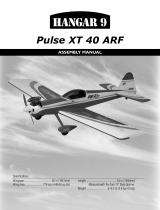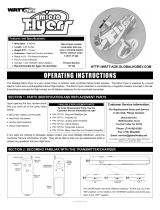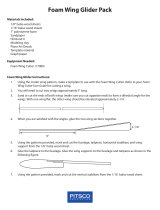Page is loading ...

Assembly Manual

2
Ta b le of Contents
Introduction ................................................................2
Table of Contents ........................................................2
Warning ....................................................................3
Additional Required Equipment ..................................3
Additional Tools and Adhesives ..................................3
Contents of Kit/Parts Layout ........................................4
Warranty Information ................................................5
Before Starting Assembly ............................................6
Using the Manual ......................................................6
Checking the Wing Washout ......................................7
Attach the Wing ........................................................8
Join the Vertical Fin and Horizontal Stabilizer ..............9
Attach the Tail to the Fuselage ..................................12
Radio Installation ......................................................14
Linkage Installation ..................................................18
Landing Gear Installation ..........................................22
Motor Break-in ........................................................25
Motor Installation ......................................................25
Battery Installation ....................................................28
Control Throws ........................................................29
Center of Gravity ......................................................31
Range Test Your Radio ..............................................32
2004 Official AMA
National Model Aircraft Safety Code ........................34
Introduction
The Gypsy EP ARF Park Flyer is a nostalgic old timer,
perfect for leisure and sport flyers who want relaxing
flights. The Gypsy offers a great flying experience with
excellent climb performance, high wing stability,
quality balsa and plywood construction, and quality
UltraCote
®
covered with an eye catching appeal.
Specifications
Wingspan: 35.25 in (895 mm)
Length: 27.5 in (698.5 mm)
Wing Area: 266 sq in (17.16 sq dm)
Weight w/o Battery: 13.5–14.5 oz (382–411g)

3
Additional Tools and Adhesives
Tools
Square Side cutters
Hobby knife Heat gun
Ruler Small pliers
Phillips screwdriver Hex wrench: 3/32"
Felt-tipped pen
Drill bit: 1/16" (1.5mm), 1/8" (3mm)
Adhesives
Medium CA
Other
Heat gun
Motor/Gearbox
370-size with 5.33:1 gearbox (included)
Propeller (10x4.7) (included)
20mm diameter w/gearbox brushless (optional)
Warning
An RC aircraft is not a toy! If misused, it can cause
serious bodily harm and damage to property. Fly only
in open areas, preferably at AMA (Academy of Model
Aeronautics) approved flying sites, following all
instructions included with your radio.
Additional Required Equipment
Recommended JR® Systems
Servos: JR 241 Sub-micro servo (2)
Receiver: JR R610M 6-channel micro FM Rx
Battery and Speed Control Requirements
Li-Po Battery: 7.4V 1900 2-Cell
7-cell Ni-MH 730mAh battery
Speed Control: 10 amp (EFLA104)

4
Contents of Kit/Parts Layout
Replacement Parts:
Main Wing EFL2051
Fuselage EFL2052
Tail Assembly EFL2053
Windshield EFL2057
Battery Hatch EFL2058
Items not shown:
Pushrod Set EFL2054
Main Landing Gear EFL2055
Wheel Set EFL2056
Decal Set EFL2059
Micro Control Horns EFLA200
Micro Pushrod Keepers EFLA201
Tailskid EFLA202
Micro Control Connectors EFLA203
370 Motor w/5.33:1 gearbox EFLM205
Micro Rubber Spinner EFLA204
10x4.7 Slow Flyer Propeller EFLP1047
Double-sided tape/Hinge Tape EFL2060

5
Optional Parts
Park 370 Brushless Motor, 4100Kv EFLM1000
10x7 Slow Flyer Propeller (2) EFLP1070
11x4.7 Slow Flyer Propeller (2) EFLP1147
11x7 Slow Flyer Propeller (2) EFLP1170
12x3.8 Slow Flyer Propeller (2) EFLP1238
12x6 Slow Flyer Propeller (2) EFLP1260
Celectra 1-2 cell Li-Po Charger EFLC3000
Celectra 1-3 cell Li-Po Charger EFLC3005
Before Starting Assembly
Before beginning the assembly of your Gypsy, remove
each part from its bag for inspection. Closely inspect
the fuselage, wing panels, rudder and stabilizer for
damage. If you find any damaged or missing parts,
contact the place of purchase.
Using the Manual
This manual is divided into sections to help make
assembly easier to understand, and to provide breaks
between each major section.
Remember to take your time and follow the directions.

6
Please note that once assembly of the model has
been started, you must contact Horizon Hobby, Inc.
directly regarding any warranty question. Please do
not contact your local hobby shop regarding warranty
issues, even if that is where you purchased it. This
will enable Horizon to better answer your questions
and service you in the event that you may need
any assistance.
If the buyer is not prepared to accept the liability
associated with the use of this product, the buyer is
advised to return this kit immediately in new and
unused condition to the place of purchase.
Horizon Hobby, Inc.
4105 Fieldstone Road
Champaign, Illinois 61822
(877) 504-0233
www.horizonhobby.com
Warranty Information
Horizon Hobby, Inc. guarantees this kit to be free from
defects in both material and workmanship at the date
of purchase. This warranty does not cover any
component parts damage by use or modification. In no
case shall Horizon Hobby’s liability exceed the original
cost of the purchased kit. Further, Horizon Hobby
reserves the right to change or modify this warranty
without notice.
In that Horizon Hobby has no control over the final
assembly or material used for the final assembly, no
liability shall be assumed nor accepted for any
damage resulting from the use of the final assembled
product. By the act of using the assembled product, the
user accepts all resulting liability.

7
Checking the Wing Washout
Required Parts
Wing
Required Tools and Adhesives
Heat gun
❍ 1. Place the wing on a flat surface and check the
wing washout. There must be 1/2" (13mm)
between the trailing edge of the wing at the tip
and work surface when the center of the wing
is flat against the work surface. If the wing is
not twisted correctly, hold the wing in a twisted
position and use a heat gun to remove the
wrinkles from the covering. Repeat the process
until the correct washout is present. The
washout makes the plane more stable in flight.

8
❍ 2. Secure the wing to the fuselage using a 4-40 x
1/2" socket head bolt and a #4 flat washer.
Note: The 4-40 socket head screw uses the
3/32" hex wrench.
Attach the Wing
Required Parts
Wing
Required Tools and Adhesives
Heat gun
Hex wrench: 3/32"
❍ 1. Place the wing onto the fuselage by guiding
the wing dowel into the hole on the
forward former.

Join the Vertical Fin and Horizontal
Stabilizer
Required Parts
Vertical fin
Horizontal stabilizer
Required Tools and Adhesives
Medium CA
Square
Felt-tipped pen
Hobby knife
❍ 1. Draw two lines on the top of the stabilizer
extending back from the sides of the notch in
the front to the trailing edge. Use a square to
make the lines 90-degrees to the trailing edge
of the stabilizer.
Note: The hole for the control horn will be on the
left side when the top is facing up.
9

❍ 2. Carefully remove the covering along the lines
using a sharp hobby knife. Be very careful not
to cut into the underlying wood and weaken
the stabilizer. If the stabilizer is weakened, it
could fail in flight.
❍ 3. Align a straight edge along the bottom of the
fin. Use a felt-tipped pen to draw a line onto
the lower front section of the fin. Draw lines on
both sides of the fin.
10

❍ 4. Remove the covering from the lower front
section of the fin 3/16" (5mm) below the
lines drawn in the last step. Also make sure
there is no covering on the bottom of the fin
as indicated. Leave the covering on the top
forward fin as shown.
❍ 5. Place the fin onto the top of the stabilizer.
The positioning of the fin will be as far back
in the notch as possible, aligned with the
covering removed from the stabilizer, and
square to the stabilizer. Use medium CA to
glue the fin to the stabilizer, keeping in mind
the three alignments.
11

Attach the Tail to the Fuselage
Required Parts
Tail assembly Fuselage
Clear tape
Required Tools and Adhesives
Medium CA
Felt-tipped pen
Hobby knife
❍ 1. Carefully remove the covering from the
fuselage from the slot in the top to the fuselage
to the very tip of the fuselage.
❍ 2. Place the tail assembly onto the fuselage. Trace
the outline of the fuselage onto the stabilizer
using a felt-tipped pen.
12

❍ 3. Separate the tail assembly from the fuselage.
Remove the covering from inside the lines
using a sharp hobby knife.
❍ 4. Place the tail assembly back in position. Before
using medium CA to attach the tail assembly to
the fuselage, stand about 10 feet away and
see if the stabilizer and wing are parallel.
Apply the CA to the slot in the fuselage where
the fin fits, and to the top of the fuselage
where the stabilizer rests. Allow the CA to fully
cure before continuing.
❍ 5. Use hinge tape on both sides of the fuselage
and rudder to hinge the bottom section of the
rudder to the fuselage
13

Radio Installation
Required Parts
Fuselage
Micro control connector (2)
Control connector backplate (2)
Two-sided tape (2)
Required Tools and Adhesives
Phillips screwdriver
Side cutters
Servo (2)
Speed control
Receiver
Drill bit: 1/16" (1.5mm)
❍ 1. Install the servo eyelets and grommets using
the instructions provided with your particular
radio system.
❍ 2. Remove the covering from the front opening on
the bottom of the fuselage. This will allow
cooling air to pass through the fuselage, and
will also help when installing the servos.
14

❍ 3. Connect the servos and battery to your radio
system as shown in the radio instructions.
Center the trim levers and turn on the radio.
This will center the servos. It is your job to
remove the servo arms and position them so
they are perpendicular to the servo.
❍ 4. Locate the micro control connector and
connector backplate. Slide the connector
through the servo arm and secure its location
using the connector backplate. Prepare two
servos with the connectors opposed to each
other as shown in the photo.
15

❍ 5. Unplug the servos from the receiver. Remove
the servo arms that are not in use, using side
cutters. Place the servos into the fuselage with
the connectors towards the outside of the
fuselage, and the servo arms towards the front
of the fuselage.
❍ 6. Use a 1/16" (1.5mm) drill bit to drill the
locations for the servo mounting screws.
16

❍ 7. Secure the servos using the screws provided
with your radio system.
❍ 8. Pass the servo leads through the opening in
front of the servos. Plug the servos into the
receiver, making sure the rudder and elevator
servos are in the correct channels. Plug the
speed control into the receiver at this time too.
17

❍ 9. Use two-sided tape to mount the receiver and
speed control to the sides of the fuselage.
❍ 10. Route the receiver antenna outside the
fuselage. Use tape to attach the antenna to the
tail. DO NOT cut the antenna, as this will
greatly reduce the radio range.
Linkage Installation
Required Parts
Fuselage
Pushrod wire (2)
Micro pushrod keeper (2)
Control horn (2)
Control horn backplate (2)
Required Tools and Adhesives
Medium CA
Small pliers
❍ 1. Remove the covering in the elevator and
rudder for the control horns.
18

❍ 2. Locate one of the control horns and slide it
through the hole in the bottom of the elevator.
Secure the control horn by snapping the
control horn backplate onto the top of the
control horn. Put a couple drops of medium
CA onto the control horn backplate to prevent
it from coming loose in flight.
❍ 3. Repeat Step 2 for the rudder control horn.
Note that the rudder control horn will be on
the opposite side of the fuselage from the
elevator control horn.
19

❍ 4. Make an L-bend in one of the pushrod wires
using small pliers.
❍ 5. Slide the pushrod wire into the pushrod tube
on the same side as the elevator control horn.
The wire will pass through the hole in the
micro control connector on the elevator servo.
❍ 6. Insert the L-bend in the pushrod through the
middle hole in the control horn.
20
/




